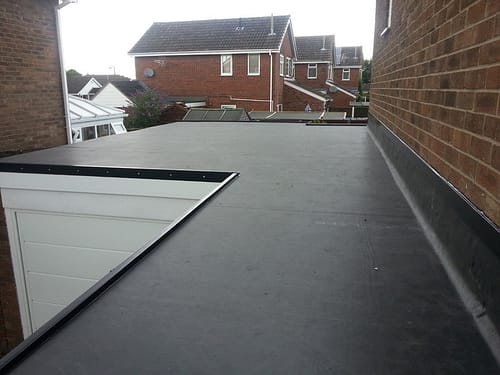 An EPDM rubber roofing system (Ethylene Propylene Diene Monomer) is one of the most common types of flat or low-slope roofs in Kansas City and throughout North America. EPDM is also referred to as rubber membrane roofing, rubber roofing, or rolled rubber roofing. It’s comprised of slate dust, recycled rubber, and sawdust. It also happens to be one of the most affordable types of roof coverings on the market at roughly $.80 per square foot.
An EPDM rubber roofing system (Ethylene Propylene Diene Monomer) is one of the most common types of flat or low-slope roofs in Kansas City and throughout North America. EPDM is also referred to as rubber membrane roofing, rubber roofing, or rolled rubber roofing. It’s comprised of slate dust, recycled rubber, and sawdust. It also happens to be one of the most affordable types of roof coverings on the market at roughly $.80 per square foot.
EPDM is a single-ply membrane comprised primarily of rubber to allow for expanding and contracting with temperature changes. This is important to your roof’s lifespan as without using a flexible surface membrane, your roof will get brittle, crack, and allow water to seep into your commercial building.
Benefits of EPDM Roofing
One of the best things about EPDM roofing material is the ease of installation. Of course a professional commercial roofer will have no problem installing most types of roofing material, but this one is so easy to install, you could probably do it yourself with very little difficulty.
This rubber layer is very lightweight and reinforcing the roof deck isn’t necessary. Quality EPDM roof systems can last up to twenty years with the proper installation. Because there are few seams, you won’t find very many leaks. When you do find a leak, repairs are pretty easy. You can hire a commercial roofing company to apply a liquid membrane, adhesive, and rubber shingles over the top of the existing EPDM roof, much like in a built-up roofing system. This type of roof also does fairly well holding up to UV rays.
Just about any roofing system will require at least some maintenance during its lifespan. Rubber roofs require the least amount of care out of all roofing systems. Industrial and commercial building owners will sometimes refinish a roof with acrylic paint every decade or so, but for the most part, maintenance on rubber roofs is very simple.
Professional Installation of EPDM Roofing
There are a few ways that commercial roofing contractors install EPDM material. They can use a strong roofing adhesive, mechanically fasten it to the roof’s surface, or weighing down the material using a ballasted approach. By using adhesive, the material is literally glued to the surface. Mechanical fasteners (screws) are the most common way to attach an EPDM roofing system to deck and prove to be the most time-efficient. Ballasted systems use gravel spread over the entire surface of the material so that it doesn’t move. In certain cases, an adhesive and ballasted approach are used to ensure a waterproof seal.
Why Use Roofing Advisors to Find an EPDM Contractor
Its more important to find a good EPDM roofing contractor than it is to decide on the systems materials themselves. Our featured commercial roofing contractor is fully licensed, bonded, and insured to install this type of material on your building’s roof and will make sure that it is watertight. Our commercial roofers have helped hundreds of businesses just like yours in the Kansas City area with repair, replacement, and new construction build-outs. Call today for a free roof estimate.
